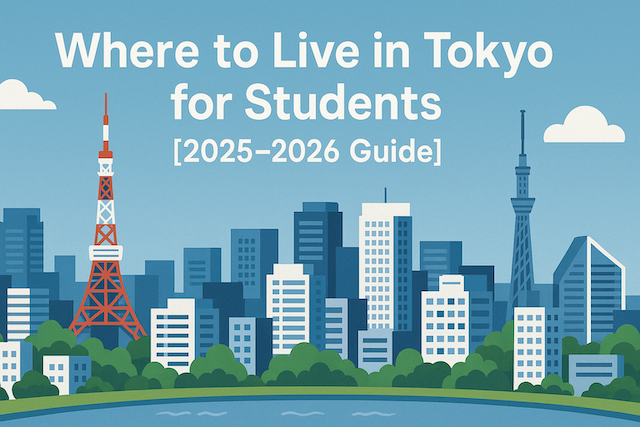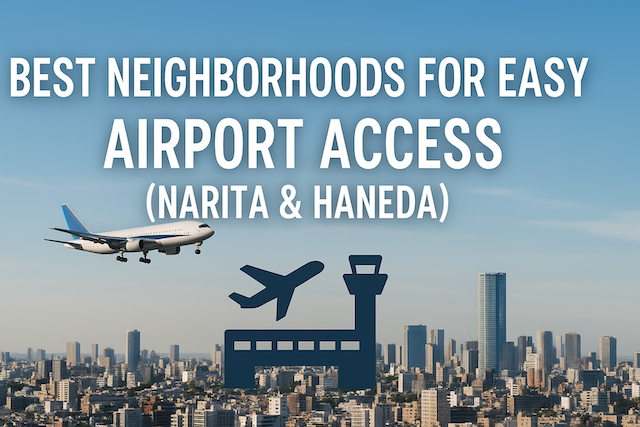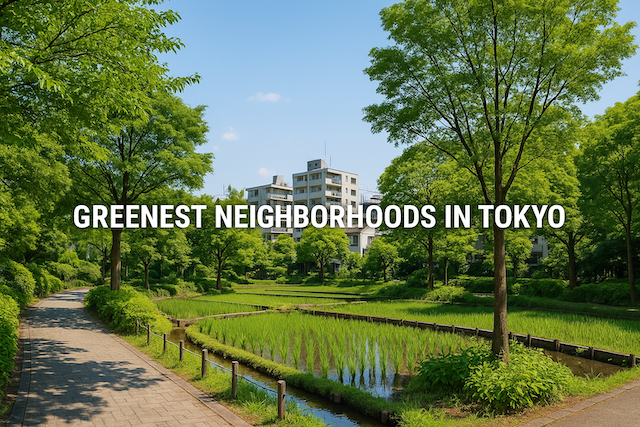Where to Live in Tokyo for Students [2025–2026 Guide]
Tokyo is one of the world’s best cities for students, offering a blend of world-class universities, diverse culture, safe neighborhoods, and countless opportunities for part-time work and entertainment. However, finding the right area to live in as a student can be challenging. Between the high cost of living and the vast size of the city, location makes a huge difference in your daily life and budget. This guide will help you choose the best areas to live in Tokyo for students in 2025–2026 — based on affordability, commute time, and lifestyle.
Understanding Student Life in Tokyo
Tokyo attracts thousands of international and local students every year. Top universities like the University of Tokyo, Waseda University, Keio University, and Sophia University are located in central or semi-central districts. Students typically look for housing with easy access to their campuses, affordable rent, and convenient transportation.
Tokyo’s transportation system is reliable, so even if you live slightly outside central Tokyo, commuting is manageable. On average, students spend 30–45 minutes commuting one way. Many prefer to live along JR Yamanote Line or metro lines that directly connect to their university area.
Factors to Consider When Choosing an Area
Before choosing where to live, consider these key points:
-
Commute time: Tokyo’s train network is excellent, but long rides can be tiring and expensive.
-
Rent: Central areas are costly; suburban areas like Suginami or Nerima offer cheaper options.
-
Lifestyle: Some areas are lively and full of entertainment, while others are quiet and residential.
-
Proximity to university: Living near your campus saves time and transportation costs.
-
Safety: Tokyo is safe overall, but some nightlife areas can be noisy or crowded.
Best Areas to Live in Tokyo for Students
1. Takadanobaba – Student Central
Best for: Waseda University students and social life
Takadanobaba in Shinjuku Ward is one of the most student-friendly areas in Tokyo. It’s home to Waseda University and many vocational schools. The area is filled with cheap eateries, karaoke, secondhand shops, and study cafés. Rent is relatively reasonable for its central location, and the atmosphere is lively but not chaotic.
Average rent:
-
1R/1K: ¥70,000–¥90,000
-
1DK/1LDK: ¥100,000–¥130,000
Pros:
-
Walking distance to Waseda
-
Many cheap restaurants
-
Great nightlife and student community
Cons:
-
Can be noisy at night
-
Limited green spaces
2. Kichijoji – Balance of Nature and Culture
Best for: Students wanting a relaxed yet trendy lifestyle
Located in Musashino City, Kichijoji is one of Tokyo’s most popular residential areas. It’s about 20–30 minutes from Shinjuku by train. Students love it for Inokashira Park, stylish cafés, and affordable shopping streets. While rent is slightly higher than other suburbs, the quality of life makes it worth it.
Average rent:
-
1R/1K: ¥80,000–¥100,000
-
1LDK: ¥120,000–¥150,000
Pros:
-
Relaxed environment with greenery
-
Vibrant but safe
-
Great for art, music, and café lovers
Cons:
-
Rent slightly higher than outer wards
-
Commute to central Tokyo can be long for some universities
3. Nakano – Budget-Friendly and Convenient
Best for: Students of Waseda, Meiji, or Tokyo University of Technology
Nakano offers an excellent mix of affordability, convenience, and local culture. It’s only one stop from Shinjuku on the JR Chuo Line, making it ideal for commuting. Nakano Broadway, a famous shopping complex for anime and pop culture, gives the area a youthful vibe.
Average rent:
-
1R/1K: ¥65,000–¥85,000
-
1LDK: ¥100,000–¥120,000
Pros:
-
Very convenient and affordable
-
Excellent access to central Tokyo
-
Energetic and diverse atmosphere
Cons:
-
Smaller apartment sizes
-
Can feel crowded near the station
4. Shimokitazawa – For Creative and Art-Oriented Students
Best for: Students studying art, fashion, or media
Shimokitazawa, located in Setagaya Ward, is Tokyo’s indie and bohemian hub. Known for its vintage shops, live music, and cozy cafés, it’s a favorite among young creatives and university students. It’s just a few minutes by train from Shibuya and Shinjuku, yet rent remains moderate.
Average rent:
-
1R/1K: ¥75,000–¥95,000
-
1LDK: ¥110,000–¥130,000
Pros:
-
Vibrant youth culture
-
Close to major city centers
-
Safe and trendy
Cons:
-
Limited large apartments
-
Can be crowded on weekends
5. Koenji – Budget and Youthful Energy
Best for: Students on a tight budget
Koenji is another great option for students looking for affordable rent and an authentic Tokyo experience. Famous for its live music venues and thrift shops, it has a mix of old-school Tokyo charm and youthful creativity. The commute to Shinjuku takes just 10 minutes.
Average rent:
-
1R/1K: ¥60,000–¥80,000
-
1LDK: ¥90,000–¥110,000
Pros:
-
Low rent for Tokyo standards
-
Rich in local culture and music scene
-
Great access to central Tokyo
Cons:
-
Limited shopping malls
-
Older apartment buildings
6. Ikebukuro – Convenient and Central
Best for: Students attending Rikkyo University or Tokyo International University
Ikebukuro is a major commercial and entertainment hub that remains relatively affordable for students. With multiple train lines and shopping centers, it’s one of Tokyo’s most convenient areas. The west side is quieter and preferred by students, while the east side offers more nightlife and shops.
Average rent:
-
1R/1K: ¥75,000–¥100,000
-
1LDK: ¥110,000–¥140,000
Pros:
-
Direct access to major train lines
-
Plenty of dining and entertainment options
-
Close to universities
Cons:
-
Busy and crowded
-
Some nightlife areas less quiet
Cost of Living for Students in Tokyo
Here’s a rough monthly estimate for student expenses in Tokyo (2025–2026):
| Expense | Estimated Monthly Cost |
|---|---|
| Rent (1R/1K) | ¥70,000–¥90,000 |
| Utilities (Electricity, Water, Gas) | ¥10,000–¥15,000 |
| Food | ¥30,000–¥50,000 |
| Transportation | ¥10,000–¥20,000 |
| Miscellaneous (Internet, phone, etc.) | ¥10,000–¥15,000 |
| Total | ¥130,000–¥190,000 per month |
Students can save by sharing apartments, living in dormitories, or finding accommodations in outer wards like Nerima, Edogawa, or Itabashi.
Student Dorms vs. Private Apartments
Student Dorms
-
Usually managed by universities or housing companies
-
Rent includes utilities and sometimes meals
-
Great for meeting other students but with less privacy
Private Apartments
-
Offers more independence
-
You can choose your preferred area and setup
-
Requires separate contracts for utilities and internet
Tips for Finding Student Housing in Tokyo
-
Start early: Begin searching at least 2–3 months before the semester starts.
-
Use student housing platforms: Websites like Suumo, GaijinPot, and Leopalace21 list many student-friendly units.
-
Check commute routes: Use Google Maps or HyperDia to estimate your daily travel time and cost.
-
Consider dorms for the first year: They simplify the move-in process and help you adjust to life in Tokyo.
-
Look for furnished apartments: Especially convenient for international students who don’t plan to stay long-term.
Final Thoughts
Tokyo offers an incredible lifestyle for students — from world-class education to rich culture and safe living conditions. Choosing the right area depends on your university’s location, budget, and personal preferences. Whether you prefer the buzz of Takadanobaba, the relaxed feel of Kichijoji, or the creativity of Shimokitazawa, there’s a perfect spot for every type of student.
In 2025–2026, Tokyo continues to evolve with improved student housing options and affordable transport passes, making it easier than ever for both Japanese and international students to live comfortably while enjoying everything this amazing city has to offer.
FAQs
What are the best areas in Tokyo for students in 2025–2026?
Popular student-friendly areas balance commute, cost, and lifestyle. Strong picks include Takadanobaba (close to Waseda, lots of cheap eats), Nakano (fast to Shinjuku, budget-friendly), Shimokitazawa (creative vibe near Shibuya), Koenji (affordable with indie culture), Kichijoji (park life and cafés), and Ikebukuro (major hub with many schools nearby). If you need lower rent, consider outer-ward options like Nerima, Itabashi, Edogawa, or parts of Suginami with direct trains into the center.
How much should I budget for monthly living costs as a student?
Most students spend ¥130,000–¥190,000 per month including rent. A typical breakdown: rent for a 1R/1K (¥70,000–¥90,000), utilities (¥10,000–¥15,000), food (¥30,000–¥50,000), transport (¥10,000–¥20,000), and internet/phone/misc (¥10,000–¥15,000). Share houses and dorms can lower costs; living alone in a central area will push you toward the higher end.
How do I choose between a dorm, share house, and private apartment?
Dorms are convenient (often furnished, utilities bundled, social) but have curfews or rules. Share houses offer flexibility, furnished common spaces, and easy move-in with shorter contracts. Private apartments maximize privacy and control but require more paperwork, deposits, and setup for utilities and internet. First-year and international students often start in dorms or share houses, then shift to private apartments once settled.
What is a reasonable commute time for students?
Tokyo’s trains make a 30–45 minute one-way commute common. Try to live on a line with a direct route to campus to avoid stressful transfers during rush hour. If lectures start early, test the route at that time before signing a lease.
How much rent should I expect in student areas?
Approximate 1R/1K rents: Takadanobaba ¥70k–¥90k, Nakano ¥65k–¥85k, Koenji ¥60k–¥80k, Shimokitazawa ¥75k–¥95k, Kichijoji ¥80k–¥100k, Ikebukuro ¥75k–¥100k. 1LDK units are usually ¥100k–¥150k+ depending on proximity to major hubs and building age.
What is key money, deposit, and agency fee?
Key money (礼金) is a non-refundable “thank you” payment to the landlord (often 0–1 month). Deposit (敷金) is refundable minus cleaning or damage. Agency fee is typically up to 1 month’s rent. Watch for additional fees like lock exchange, guarantor company, and fire insurance. No-key-money listings exist; filter for “礼金なし.”
Do I need a guarantor or can I use a guarantor company?
Most private rentals require either a personal guarantor in Japan or a guarantor company (保証会社). International students often use a company; fees are commonly 30–100% of one month’s rent (sometimes with annual renewals). Universities and international support centers can provide guidance.
Which documents are required to rent?
Prepare: passport, residence card (or COE if pre-arrival cases allow temporary holds), student ID or admission letter, proof of income or scholarship, emergency contact in Japan, and bank details. For share houses and dorms, requirements may be lighter, but always check the operator’s checklist.
When should I start the housing search?
Begin 2–3 months before the semester start. Spring move-in (March–April) is peak season; inventory turns over rapidly. If you arrive in off-peak months, you may secure better deals or negotiate move-in dates and minor concessions.
How can I keep rent and setup costs low?
- Choose older but well-kept buildings slightly outside the center with direct train lines.
- Target “no key money,” low deposit, and furnished or appliance-included units.
- Consider share houses to avoid buying furniture and paying multiple upfront fees.
- Negotiate on move-in dates, cleaning fees, or minor repairs when possible.
Is it better to live near campus or near a major station?
Near campus means shorter days and lower transport costs—great for lab-heavy or club-heavy schedules. Near a major hub (e.g., Shinjuku, Shibuya, Ikebukuro) gives job access, nightlife, and easy transfers but can be pricier and noisier. Map your weekly routine (classes, part-time work, clubs) and choose based on time saved overall.
How do utilities and internet work?
For private apartments, you’ll set up electricity, gas, water, and internet. Many landlords can recommend providers; some buildings include internet or have bulk plans. Utilities average ¥10k–¥15k/month for a solo student. In dorms/share houses, utilities are often bundled into a fixed fee.
Are part-time jobs easy to find for students?
Yes, especially near commercial hubs and university districts (cafés, convenience stores, tutoring, restaurants). International students need a “Permission to Engage in Activity Other Than That Permitted” stamp and must respect hour limits. English-speaking jobs exist, but basic Japanese greatly broadens options.
Is Tokyo safe for students? Any neighborhood caveats?
Tokyo is one of the world’s safest big cities. Student areas are generally calm, though nightlife zones near big stations can be noisy and crowded. Choose well-lit streets, secure building entrances, and avoid top-floor walk-ups if you prefer quicker evacuation in emergencies. Always test the night vibe before committing.
What should I look for during apartment viewings?
- Commute test at peak times; check last-train options.
- Noise levels (train tracks, bars, schools, roads).
- Natural light, ventilation, mold signs, and storage.
- Appliances included (AC, fridge, washer), and condition.
- Internet readiness and mobile signal strength.
- Security: intercom, auto-lock, door chain, neighborhood lighting.
Are furnished apartments common?
They exist but are less common in traditional rentals. Look for furnished or appliance-included listings, or use furniture rental services. Share houses are typically furnished; dorms vary by operator.
Can I have a pet?
Many student-friendly units are no-pet. If you need a pet-friendly place, filter specifically for it (“ペット可”). Expect higher rent or extra deposits, and fewer options near the center.
How do I avoid rental scams and bad contracts?
Use reputable agencies and platforms with verified listings. Be wary of deals that demand full payment before a viewing or contract. Read the contract carefully (check lease term, renewal fee, penalties, cleaning charges, and subletting rules). When unsure, have a Japanese-speaking friend or your university support office review key terms.
What is the typical lease length and can I leave early?
Standard leases are 2 years with renewal fees (often one month’s rent or a set amount). Early termination usually requires 1–2 months’ notice; some contracts include penalties if you leave in the first year. Confirm all exit costs before signing.
How do waste sorting and building rules work?
Tokyo has strict sorting: burnable, non-burnable, plastics, cans, bottles, and sometimes PET bottles separately. Buildings have posted schedules and collection points; fines or warnings are possible for repeated violations. Quiet hours are common—respect them to keep good relations with neighbors.
Any tips for earthquake preparedness in small apartments?
Install simple anti-tip brackets for shelves, don’t store heavy items high, keep an emergency kit (water, food, flashlight, battery pack, first-aid), and know your building’s evacuation route. Consider renters’ insurance that covers quake-related damages if available.
What are good platforms and services for student housing?
Check major portals (e.g., Suumo, Homes, CHINTAI), international-friendly sites (GaijinPot Housing), and university-affiliated housing offices. For short stays or easy move-ins, look at share house operators and student residence providers. Social groups and campus boards can surface sublets and roommate matches.
How can I keep transport costs down?
Choose a place on a direct line to campus, buy commuter passes for the exact segment you use, and walk or cycle for “last mile” connections. Living one or two stations farther out on the same line often saves thousands of yen monthly with only a small time trade-off.
What lifestyle differences should I expect in student areas?
Near large campuses you’ll find late-night eateries, budget cafés, secondhand shops, and study-friendly environments. Weekends can be lively (music venues, festivals, shopping arcades). If you prioritize quiet study, pick residential streets a few minutes from the station rather than directly above nightlife corridors.
Bottom line: how do I decide fast and confidently?
- Define your non-negotiables: budget ceiling, max commute minutes, preferred vibe.
- Shortlist 2–3 lines that connect directly to campus.
- Tour multiple units in one day; bring a checklist and videos.
- Verify fees and exit conditions; avoid hidden costs.
- If you’re new to Japan, start in a dorm or share house, then “graduate” to a private apartment once you know the city.


![Where to Live in Tokyo for Singles [2025–2026 Guide]](https://tokyorelocationguide.com/wp-content/uploads/2025/10/ChatGPT-Image-Oct-17-2025-04_03_58-PM.png)




![Where to Live in Tokyo for Couples [2025-2026 Guide]](https://tokyorelocationguide.com/wp-content/uploads/2025/10/ChatGPT-Image-Oct-17-2025-04_22_42-PM.png)